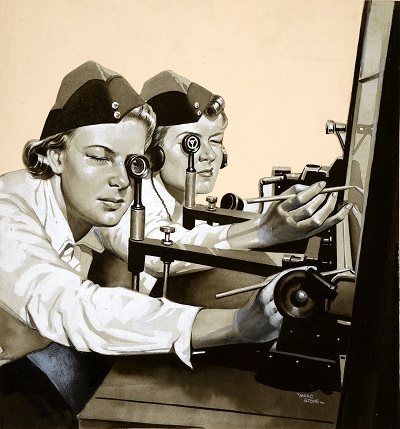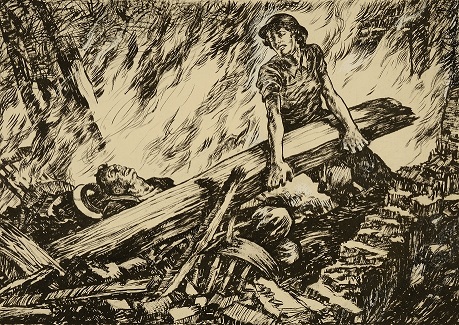Our Keeper’s Gallery currently features a display highlighting women represented in original artwork from the Second World War. These artworks are being shown in the gallery to mark the 70th anniversary this year of Victory in Europe Day on 8 May 1945, and as part of Women’s History Month in March. During the First World War women volunteered to undertake various roles to help the war effort (read more about this in yesterday’s blog post, A woman’s war 1914-1918). As the Second World War approached, it was clear the demand for labour would increase. From 1941, every woman in Britain aged 18-60 had to be registered to work and later that year conscription of women was introduced. In 1943, almost 90% of single women and 80% of married women were employed as part of the war effort. Women worked in numerous areas during the Second World War, in paid as well as voluntary positions. This display of original artwork from the INF 3 record series highlights just a few. INF 3 includes 1861 pieces of wartime propaganda art produced for the Ministry of Information during the Second World War. It includes works by dozens of artists in a variety of media.
Home front woman at rescue work, 1939-1946, artist unknown
The main civil defence services during the Second World War were Air Raid Precautions (ARP), the National Fire Service and the Women’s Voluntary Service (WVS). The WVS was set up in 1938 to involve women in ARP. This artwork depicts a women in rescue work. Initially women in the civil defence services mainly carried out clerical duties. This particular artwork was produced for publicity in Latin America.
Ditty box WRNS ratings,1939-1946, artist Olga Lehmann
The Women’s Royal Naval Service (WRNS), popularly known as the Wrens, was the female branch of the Royal Navy. Initially formed during the First World War it resumed operation at the beginning of the Second World War. Women aged 18-50 and living near naval ports could apply. The WRNS included electricians, air mechanics, weapons analysts and wireless operators. A ditty box, which is referred to in the title of the artwork, was a wooden box for a sailor’s belongings or tools. Chilean-born British artist Olga Lehmann (1912 – 2001) exhibited with the Royal Portrait Society in the 1930s and later became a designer for the Radio Times and for film.
ATS girls in gunnery control positions, 1939-1946, artist Marc Stone
The Auxiliary Territorial Service (ATS) was the women’s branch of the British Army during the Second World War. The ATS initially wanted to recruit women volunteers for driving, cooking and typing but in 1939 it was in action in France with the British Expeditionary Force. Roles carried out by women included manning searchlights and anti-aircraft guns, though they were not allowed to fire the guns. With over 250,000 serving women, the ATS was the largest women’s service during the Second World War.

ATS girls in gunnery control positions, 1939-1946, artist Marc Stone, catalogue reference: INF 3/1235
This display will be in the gallery until 28 August 2015.

